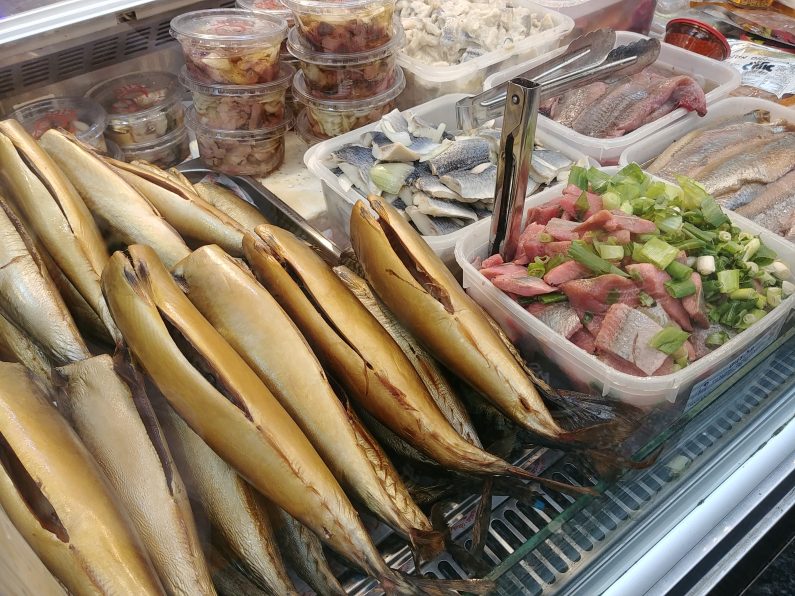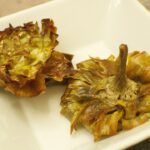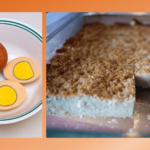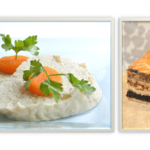Traditional Jews have a wide array of food blessings, based on the type of food being consumed. We thank God with a different bracha (blessing) for creating grain products, fruits or wine, for example. These add up to an expression of our gratitude to the Creator for providing us not just with sustenance, but with a variety both nutritionally and to meet individual tastes. In my opinion, however, we should also have a special bracha to thank God for making food spoil. No, seriously.
The number and types of foods throughout history that were created solely as a means of food preservation are legion. If food products never spoiled, humans might never have created beer, sushi, grape jam or sausage. Without those, and the thousands of similar products, world gastronomy would be unimaginably more boring! Necessity is indeed the mother of invention, and only because the chemistry and biology of this world make food lose quality over time did humans apply their imaginative powers to combat the problem.
Jews are not unique in their adoption of preservation techniques. But as a literally global nation, we’ve had exposure to nearly every cuisine of the world. Thus, the beloved preserved foods of our people are an extremely diverse collection. In this post, I want to pay tribute to some of those foods, and through them, in turn, thank God for making food spoil in the first place!
But First, Some Background…
Let’s start by quickly exploring the ways in which food spoils, and some of the techniques that combat that spoilage. (If you have no interest, just scroll right down to the next section where I talk about Jewish examples of preserved foods.)(1)Most of the information in this section has been culled from various entries in The Oxford Companion to Food, 3rd ed., Alan Davidson
For starters, not all food spoilage is the same, but the processes all begin immediately upon the death of a plant or animal. Enzymes already in the food can break food down, softening it. While the beginning of this process can be beneficial (softening meats or ripening fruits), too much of it leads to rot. Microorganisms such as bacteria, molds or yeast can also have a wide array of effects on food, both wanted and unwanted. So strictly speaking, “spoilage” is a subjective term when it comes to food; one person’s spoiling is another’s fermentation or ripening. Finally, there is also one spoilage process which is more universally seen as negative and which results from a strictly chemical process: rancidification of fats. In that process, fats exposed to air oxidize and gain an unpleasant smell and taste. Virtually all food spoilage that occurs naturally stems from one of these causes.
The challenge for human food processors was not only how to prevent those various processes from taking place, but also how to simultaneously permit the desired procedures to continue. Throughout history, numerous techniques have developed, and often a few are used in conjunction with each other. Cooking itself is the most obvious method, though that only preserves food for a short amount of time. It denatures the enzymes and eliminates most bacteria and molds. Of course, after it is removed from the heat, new contaminants can still affect the food, and spoilage can begin once again.

Salting may also have grown out of drying, as salt has long been recognized as a substance that draws liquid out of substances. Via osmosis, the saline solution of any liquid in a salted food prevents microbes from crossing cell walls, thus preventing spoilage. Salting may be done either with dry salt or by submerging a food in a salty brine. Some favorable bacteria — those that produce lactic acid — thrive in solutions that are more saline than most other bacteria can survive, so mild salt solutions can be used for one of the types of pickling processes (more on that later). A different type of pickling involves the direct application of an acid, such as vinegar, rather than allowing bacteria to produce its own acid.
Sugar and other spices, such as garlic, though less effective, still can play a roll in food preservation by acting as antiseptics, dehydrators or sealants against air. Finally, classical fermentation is also a food-preservation method, converting sugar into alcohol. Some scholars suggest that beer might have first been invented as a way of preserving the nutrients of grain before it rotted away. Others reverse that causality, claiming that the desire for more beer led to more grain production. Either way, there is no doubt that the beer lasted longer than the cereal crops from which it was made.
What the Jews Did with All This
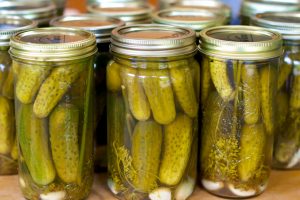
Of the Seven Species that the Torah says were abundant in the Land of Israel, four of the five fruits have commonly been preserved. Grapes and figs were dried and often pressed into cakes, as evidenced by numerous references in the Biblical books of the prophets. Dates can be eaten fresh, but historically have always been more popular in dried form. And while olives were originally cultivated for their oil, they eventually became eaten as a fruit in and of themselves. However, in order to be edible, olives must first be softened and have a bitter, mildly poisonous substance leached out by soaking the fruit in a salty brine. All four of these have remained popular in Jewish cuisine, particularly throughout the broader Mediterranean region.
Another preserved fruit became particularly popular in North African cuisine. Preserved lemons layer slices of the sour fruit in a salt or sugar-and-salt coating. From Egypt to Morocco, these are a huge part of Jewish cuisine in the region. Other fruit preserves/jams — particularly those made of quince — are popular from Turkey through Syria and into Persia as a treat eaten on Rosh Hashanah, symbolizing a sweet new year. Hungarian Jews are famous for the plum preserves, and even commonly preserved the sukkot etrog (citron).(2)Andras Koerner, Jewish Cuisine in Hungary
What about vegetables? Eastern European Jews commonly gathered wild mushrooms, a free and delicious food source, as I wrote in my article about krupnik soup. They would lay them on top of their stove to dry for use once the mushrooms were no longer in season.
But probably the most famous example of Jewish vegetable preservation is the classic Ashkenazi pickled cucumbers. What differentiates this kind of pickle is that it is made without vinegar, relying instead on lacto-bacillic fermentation alone. Thus, it is made in a salt solution with no added acids. The resulting pickle features numerous health and digestive benefits, not to mention an exquisite taste. True sauerkraut is also the product of lactic fermentation, and is a classic element of Alsatian and German Jewish cuisine. Sephardic and Middle Eastern communities feature their own pickled vegetables. While theirs typically rely on vinegar, they also feature a wider array of common vegetables, ranging from cabbage and celery to carrots and turnips.
Meats and Fish
Probably the most beloved preserved foods, however, are proteins. And their preservation was always the most necessary, too. Most animals could not be eaten in a single sitting, and thus ran the risk of spoilage before they were fully consumed. Fish would also need preservation so people who lived far from water sources could consume them as well. Jews in Kurdistan, for example, ate different types of preserved meats; though there was a good amount of grazing land and abundant livestock, rural Kurdish Jews typically had no shochet (ritual slaughterer) of their own, and relied on itinerant shochetim who might slaughter in each community only once or twice a year. Thus, preservation allowed them to have meat throughout the year. Qalya was made by rendering the tail fat of sheep, then submerging pieces of partially cooked meat in that melted fat, while Qawürma was sliced beef that was then pickled. A third type, similar to South African biltong was salted and air-dried.(3)Erich Brauer, The Jews of Kurdistan

Jews worldwide considered fish an opportune element for Friday night dinner. But this, of course, caused difficulties for those who did not leave close to a body of water. For Ashkenazi Jews in Eastern Europe, herring of all kinds was the preeminent solution. Various types of pickles, saltings and even sometimes smoking was applied to this inexpensive and abundant fish. Italian Jews commonly ate a salt cod called baccala that required 24 hours of soaking to reconstitute!(4)Edda Servi Machlin, The Classic Cuisine of the Italian Jews I, 175-176 And American “appetizing stores” (the dairy takeout equivalents of meaty delicatessens) became synonymous with smoked fishes, from white fish to the nova salmon that would top every bagel-with-schmear.
Best of the Rest
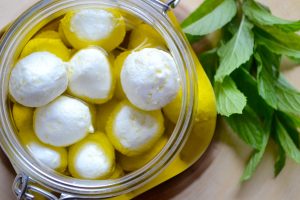
And speaking of fermentation, I’ll end with the popular fermented products that are most beloved to Jews. I’ve got an hour-long food talk on the history of Jews and alcohol, so I’ll just mention a few points here. Throughout history, Jews have been wine-producers, in order to be able to make kiddush on Friday night. Jews from Morocco to Yemen to Kurdistan have a famous love for anise-flavored distilled spirits, including arak (potentially even invented by Jews) and one of the genuinely unique Jewish alcoholic beverages, mahia. And syrupy Manischewitz-style kiddush wine is so synonymous with 20th-century American Jewry that many Jews won’t have their Seder without it (even if they prefer the taste of good quality wine, kosher or otherwise).
This post was really just a survey, but many of the links will help you make these products yourself if you want to. Jews are certainly not unique in preserving foods. Quite the opposite: we are just like everyone else throughout history! But there is no doubt that we have certainly contributed many of our own products or twists on classics, helping diversify world gastronomy with more preserved food options. With over a billion tons of food wasted each year worldwide, perhaps a refocused attention on food preservation methods can help reduce that amount a little bit at a time.
That’s a way to truly thank God for the food he created. And for making it spoil!
Footnotes
| ↑1 | Most of the information in this section has been culled from various entries in The Oxford Companion to Food, 3rd ed., Alan Davidson |
|---|---|
| ↑2 | Andras Koerner, Jewish Cuisine in Hungary |
| ↑3 | Erich Brauer, The Jews of Kurdistan |
| ↑4 | Edda Servi Machlin, The Classic Cuisine of the Italian Jews I, 175-176 |

